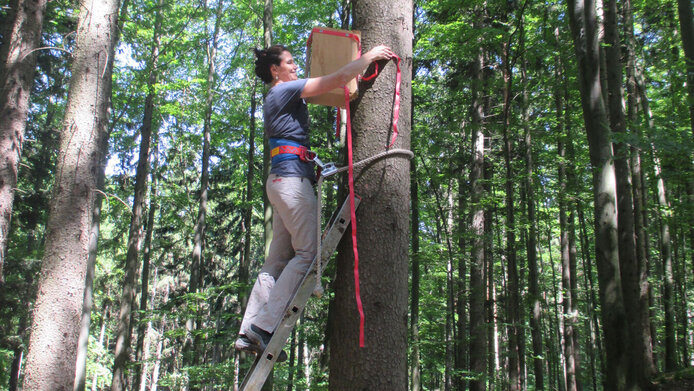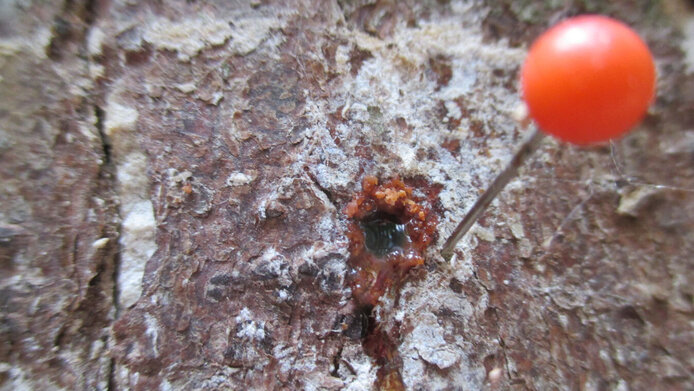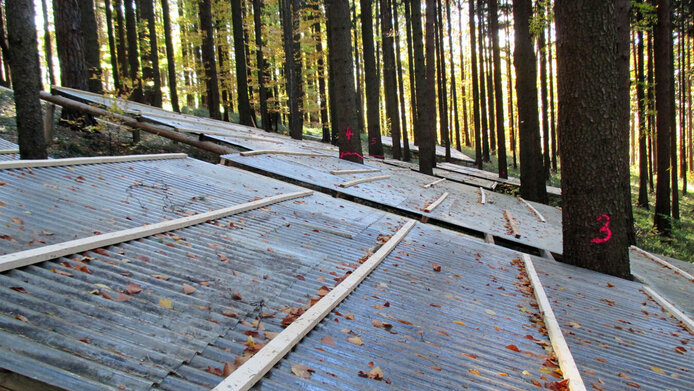How spruce meets bark beetle

It is fortunate that Sigrid Netherer's field-test area was located in the teaching forest of the University of Natural Resources and Applied Life Sciences in the border region between Lower Austria and Burgenland. There is no-one around to complain when this forest entomologist (i.e. specialising in the entomology of beneficial insects and pests in forests) builds roofs over trees for testing, attaches infestation boxes or shoots branches out of the treetop at dawn with a shotgun. It’s all in the service of science. In addition, the highland forest is managed in a textbook manner as a mixed forest, which keeps a massive spread of the Eurasian spruce bark beetle (Ips typographus) at bay. For her FWF-funded Elise-Richter project, Netherer compared ten spruce trees shielded from precipitation by roofs with ten control trees over two seasons, and she also took bark beetles from the breeding facility in the basement of the University of Natural Resources and Applied Life Sciences out into nature. An elaborate test set-up and the very committed team at the Institute of Forest Entomology, Forest Pathology and Forest Protection (IFFF) made it possible to obtain the first empirical proof that drought-stressed spruce trees are indeed particularly attractive for bark beetle pioneers, i.e. for the first males that scout the tree.
Well-adapted and known from old
Observations reveal that the spread of spruce bark beetle, the most important pest infesting spruce trees, is favoured by the increasing heat and dryness of human-made climate change and that several beetle generations develop within a single year. “Publications more than a century old already contain the observation that dry and warm periods promote the beetle’s mass reproduction,” notes Netherer. While there have been observational and modelling studies that match climate data and quantities of damaged wood, studies that establish connections between what happens in the tree, the behaviour of the bark beetles and the fungi with which they live in symbiosis are few and far between. In a previous FWF-funded project, the entomologist already examined individual trees, tested procedures for modelling drought stress, and developed the system of infestation boxes to observe the behaviour of bark beetles on trees. In her current project, which will lead to her professorial qualification, Sigrid Netherer is now working on the following questions: What changes in the tree’s biochemistry and physiology does drought stress produce? What influence does this have on the tree’s defence behaviour? How attractive do bark beetles find stressed trees? And how well can spruce trees defend themselves against the blue stain fungi that live in symbiosis with the spruce bark beetle?
Water shortage and resin production
In the course of evolution, spruce trees and bark beetles have adapted to one another. Males known as pioneer beetles use their sophisticated sense of smell to choose trees to invade. Subsequently they process resin components into attractant substances that serve as a sort of dinner call to their colleagues: “The buffet is open!” Only mass reproduction will enable the beetles to overcome the tree's defence system. In 2019 and 2020 the research team went to work in an older stand of spruces (80 years and older) in the Rosalia Mountains, the north-eastern foothills of the Alps. Ten trees were shielded from rainwater with roofs close to the ground and ten were sampled as control trees. The researchers regularly determined the soil moisture in the root zone, the resin flow and the amount of resin, the branch water potential, and the composition of the constituents in the resin. The latter was done with the support of the Max Planck Institute for Chemical Ecology in Jena and the Nova University Lisbon (UNL).
In addition, infestation boxes were used to test the attractiveness of both the stressed and the non-stressed trees for bark beetles. In the second year, the team also tested the immune defence of the trees against blue stain fungi, which always comes in the wake of the bark beetle. “Conifers use resin for defence. The smell typically associated with a forest is produced by terpenoid substances in the resin. The amount of the resin, and the composition and concentration of its ingredients determine how well trees can defend themselves. This is very individual.”
Studying infestation boxes and Petri dishes
In order to bring together beetles and trees in a targeted manner, the researchers installed several infestation boxes, each equipped with 20 freshly hatched spruce bark beetles from the breeding facility of the Vienna University of Natural Resources and Applied Life Sciences. After 24 hours, the researchers checked the reaction of the beetles (e.g. abandoning the tree, boring its way in, hiding under the bark, remaining inactive). In the second year of the study, the researchers then inoculated the twenty spruce trees under observation with blue stain fungi (Grosmannia penicillata). After four and six weeks, respectively, they measured the defence reaction of the trees. The size of the wound reaction zone is a measure of how long the trees needed to stop the growth of the fungi.
Findings evaluated to date from the field study support the theory of “drought stress as a gateway”, but the most interesting result came from an additional observational study in the laboratory. Male pioneer beetles were offered a choice of two bark samples in a petri dish: one included bark and bast from the twenty trees under study (with and without a roof) and the other had tissue from vital spruce trees from the same forest that were not part of the drought stress experiment. The pioneers had 60 minutes to test, taste, smell and select. “The beetles more often chose the stressed trees. They also showed a clear preference for samples that came from trees with limited defences. This is the first empirical evidence for primary attraction, meaning that the spruce bark beetles probably actively scout for drought-stressed trees with limited defences.”
The chemical analyses of the infestation box trials showed that trees with many borings (bark beetles bore through the bark) always had lower concentrations of ingredients in the resin. It would be interesting to know exactly which combinations of bark ingredients or specific substances made a tree attractive for bark beetle infestation. In order to find out, additional samples are now being evaluated for further ingredients, including phenols.
Personal details
Sigrid Netherer studied forestry at the University of Natural Resources and Applied Life Sciences, Vienna. She worked as a research assistant at the Institute of Forest Entomology, Forest Pathology and Forest Protection (IFFF) for two years and, after a maternity leave in 2006, returned as a postdoc. Between 2005 and 2012 she also worked as a freelance forestry consultant was and involved in environmental education for children. She worked part-time in European Commission projects and as of 2011 conducted FWF-funded projects as a principal investigator. In January 2022 she acquired her professorial qualification. Funded by the FWF with EUR 350,000, the project Drought-mediated host tree-bark beetle interactions is set to run until June 2022.
Publications
Netherer S., Kandasamy D., Jirosová A., Kalinová B. et al.: Interactions among Norway spruce, the bark beetle Ips typographus and its fungal symbionts in times of drought, in: Journal of Pest Science 2021
Netherer S., Schebeck M., Morgante G., Rentsch V., Kirisits T.: Spruce bark beetle, Ips typographus, males are attracted to bark cores of drought-stressed Norway spruce trees with impaired defenses in Petri dish choice experiments, submitted to Forests







